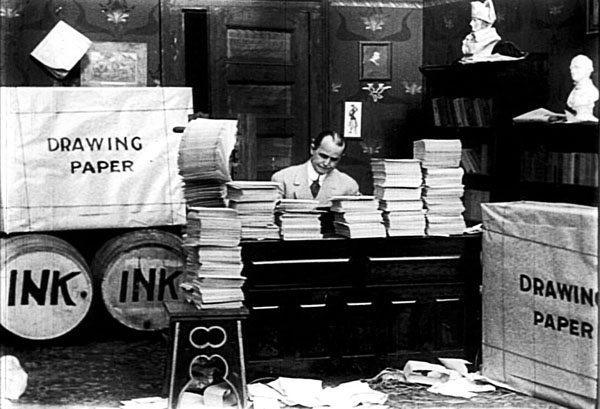
 American animated cartoons began with Winsor McCay Makes His Cartoons Move, released in 1911. That film introduced the world to the concept of someone sitting at a desk creating a sequence of drawings for the purpose of simulating motion. The scene was staged, probably at the Vitagraph studio in Brooklyn. Winsor McCay actually drew the cartoon portion of that movie at his home on Long Island, making New York City, with its five boroughs, the indisputable birthplace of American animated cartoons.
American animated cartoons began with Winsor McCay Makes His Cartoons Move, released in 1911. That film introduced the world to the concept of someone sitting at a desk creating a sequence of drawings for the purpose of simulating motion. The scene was staged, probably at the Vitagraph studio in Brooklyn. Winsor McCay actually drew the cartoon portion of that movie at his home on Long Island, making New York City, with its five boroughs, the indisputable birthplace of American animated cartoons.
Winsor McCay’s romp into this new art form is exquisite (and I don’t use that word much). His hand-painted characters frolic about, displaying perfect perspective and proportion. It is a masterpiece decades ahead of those who followed the trail he blazed.
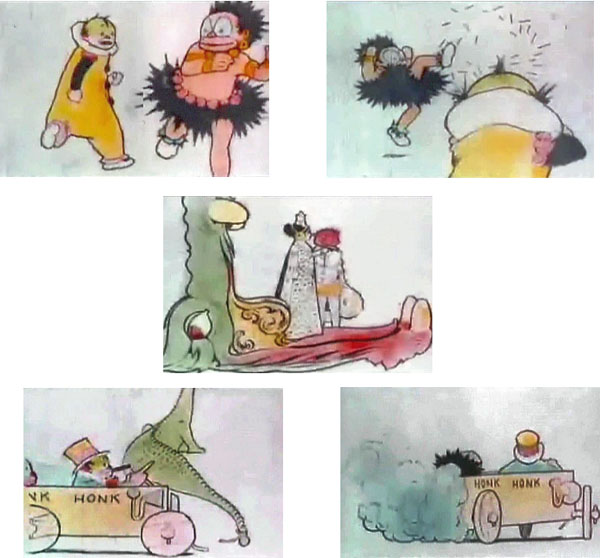
A year later McCay released his second animation THE STORY OF A MOSQUITO. Less ambitious than the first, this cartoon still has some intriguing elements. Before Winsor McCay could finish his third, and most famous, cartoon film, other artists were in the game. What they did, we now study.
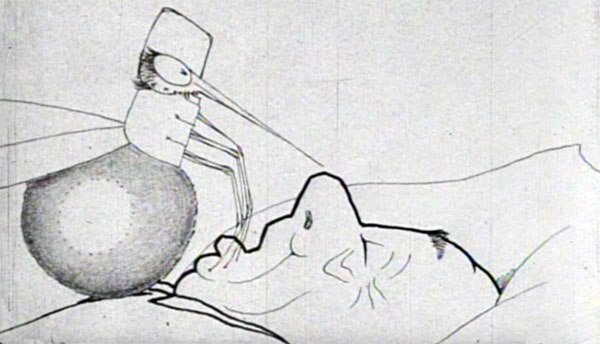
My own path leading to my becoming an animation researcher started with the book Of Mice and Magic, as, I suspect, it did for many of you. My local library had a hardcover in the discard bin for fifty cents. While reading it I made some notes, thinking about how much more had happened since Leonard Maltin published the book in 1980.
 Internet searches beefed up my notes until eventually I needed to fact check something and ended up calling J.J. Sedelmaier Productions, hoping to talk with someone who remembered. To my surprise J.J. Sedelmaier answered the phone. He was too busy to talk, but promised to call me back after hours. To my even bigger surprise he did. We spoke of Speedy Alka Seltzer and J.J. warmly recalled his departed friend Jan Svochak. That was my first contact with the New York animation community.
Internet searches beefed up my notes until eventually I needed to fact check something and ended up calling J.J. Sedelmaier Productions, hoping to talk with someone who remembered. To my surprise J.J. Sedelmaier answered the phone. He was too busy to talk, but promised to call me back after hours. To my even bigger surprise he did. We spoke of Speedy Alka Seltzer and J.J. warmly recalled his departed friend Jan Svochak. That was my first contact with the New York animation community.
My notes continued to grow, swelling into an idea for a book, or rather a trilogy covering theatrical cartoons, television toons, and computer generated imagery. I decided to focus on 1913 to 2013, the industry’s first century of existence.
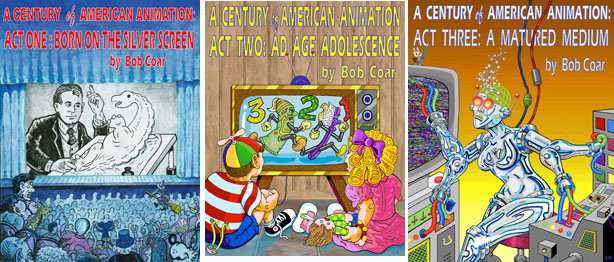
From that point on the problem developed about having something new to say. Endless hours of research followed. By chance Linkedin brought me to Santiago Cohen, who conducted me to R. O. Blechman. Contact with Phil Kimmelman followed. Phil told me great stories, and introduced me to Dante Barbetta, Arnie Levin, Carol Favata, Bill Peckmann, and since I’m on a name dropping spree, the invaluable Howard Beckerman.
Speaking with these talented people made me realize the rich history of New York’s animation scene. One fellow researcher turned me on to the Media History Digital Library:
https://mediahistoryproject.org/
This wonderful website houses a collection of old movie trade publications that can be word searched. One tip I can give is that when trying to decide between typing in ANIMATION, or typing ANIMATOR, or else ANIMATED, a simple ANIMAT will bring all three up.
Another useful website for NYC research stores digitalized phone books!
I began compiling a database of information on American animation studios, hundreds of them in the New York area. As it turns out, J.J. Sedelmaier had been working on his own file of New York studios. We bumped heads to gather an extensive list of some five hundred studios spanning from Winsor McCay’s groundbreaking efforts on Long Island up till modern day. Jerry Beck has encouraged me to convert that list into a series of articles, so here goes –
New York City consists of five boroughs. I’ve previously covered animation activity in the Bronx. Staten Island played no significant role. Brooklyn and Long Island did. The bulk of NYC animation studios were in Manhattan, an island running 13.4 miles longitudinally and 2.3 miles latitude wise. Manhattan is bordered by the Atlantic Ocean to the east, and the Hudson River to the west. The property is valued at $24 in trinkets, according to the latest figures I’ve seen.
Streets run pretty much east and west, while Avenues are sort of south to north, The lower end of the Island developed without any singular design, but above 13th Street a planned grid emerges. That grid tilts rightward at about 29 degrees. First Avenue runs along the Atlantic Ocean. What is considered the more upper-crust “East Side” ends at Fifth Avenue. Over by Eleventh Avenue is the hard scrabble neighborhood known as Hell’s Kitchen, which gives us WEST SIDE STORY.
Early in animation’s history two major hubs emerged in New York City, both around the Times Square district.

From an addendum to the studio list:
1600 Broadway: Built 1902. 10 floors. Known as the Studebaker Building., or sometimes the Mecca Building. Completed 1902. Torn down 2008.
Tenants include: UNIVERSAL ANIMATED WEEKLY (1915) * PAT POWERS PRODUCTIONS (1916) * THE MUTT AND JEFF CARTOON COMPANY (1916) * HARRY PALMER, INC. (1917) * TONY SARG (1923) * RED SEAL PICTURES (1923-1926) * OUT OF THE INKWELL FILMS/INKWELL STUDIOS (1923-1927) * L.B. CORNWALL, INC. (1925) * WARNER BROTHERS (1927) * FLEISCHER STUDIOS (1929-1938) * HOFFBERG PRODUCTIONS, INC. (1940-1943) * JOHN BRANSBY PRODUCTIONS (1940-1952) * VALENTINO MAJOR RECORDS (1942-1949) * CINEFFECTS (1945-1949) * TELENEWS PRODUCTIONS, INC. (1948-1950) * AMERICAN FILM PRODUCTIONS (1948-1966) * KNICKERBOCKER PRODUCTIONS (1948-1960) * NATIONAL SCREEN SERVICE CORP. (1950-1987) * ANIMATED PRODUCTIONS (1951-1995) * C&G FILM EFFECTS (1951-1966) * VAN PRAAG PRODUCTIONS (1951-1980) * AL STAHL PRODUCTIONS (1952-2001) * CHARLES E. SKINNER PRODUCTIONS (1952-1964) * WILLIS PYLE PRODUCTIONS (c.1953) * GEORGE BLAKE ENTERPRISES (1954-1961) * MICKEY SCHWARZ PRODUCTIONS (1956-1959) * CLAYTON W. COUSENS PRODUCTIONS (1957-1958) * WCD, INC. aka WONDSEL, CARLISLE & DUNPHY (1958-1969) * COUSENS-BLAIR & CO.(1959-1961) * KLAEGER FILM PRODUCTIONS (1959-1960) * MEL GOLD PRODUCTIONS (1961-1963) * BYRON RABBITT (1961-1963) * TOTAL GRAPHICS, INC.(1969) * VIKING FILMS (1980-1989)
729 Seventh Avenue: Known as the Godfrey Building. Completed 1915. Sixteen stories.
Tenants included: INTERNATIONAL FILM SERVICE (1915-1918) * A. KAY COMPANY (1917) * KEEN CARTOON CORP (1917) * EDUCATIONAL PICTURES (1917) * RED SEAL PICTURES EXCHANGE (1923-1926) * BRAY STUDIOS (c.1927-c.1968) * VAN BEUREN STUDIOS (1933-1936) * RUBY FILM COMPANY/RUBY CAMERA EXCHANGE (1934-1959) * HOFFBERG PRODUCTIONS, INC. (1937-1938) * VALENTINO MAJOR RECORDS (1938-1941) * TED NEMETH STUDIO (1946-1967) * SCREEN GEMS (1951) * UNITED ARTISTS TELEVISION, INC. (1969-1982) * MAGNO SOUND & VIDEO (1988-2018)
723 Seventh Avenue: Originally known as the Robertson-Cole Building (after the distributors of Charles Mintz’s KRAZY KAT) Completed 1920. 12 floors. By 1924 it was called the Powers Building (so named for Pat Powers). The Associated Recording Studio there from 1946 to 1985 was used by Woody Guthrie and Albert Einstein.
Tenants included: WILSON EXCHANGE (1925) * CELEBRITY PRODUCTIONS (1927-1947) * JACQUES KOPFSTEIN (1928) * WALT DISNEY STUDIOS (1930) * CINEMOTION STUDIOS (1932-1933) * POST PICTURE CORP (1938-1947) * METRO-GOLDWYN-MAYER (1945) * C&G FILM EFFECTS (1947-1950) * MURPHY-LILLIS, INC. (1952) * OWEN MURPHY PRODUCTIONS (1952-1962) * BILL STURM STUDIOS (1955-1959) * COUSENS PRODUCTIONS (1960) * MAGNO SOUND & VIDEO (1963-1973) * COMMONWEALTH FILM & TELEVISION, INC (1969) * EFX UNLIMITED (1969)
Those odd shaped triangular blocks are caused by Broadway slicing through the grid at angles all its own. Aside from that, a typical Manhattan city block is 246 feet between streets, and 984 feet between avenues. Exactly four times long as they are wide. A network of alleys and arcade style buildings keep foot traffic flowing.
Manhattan’s other animation hub is Popeye Alley:
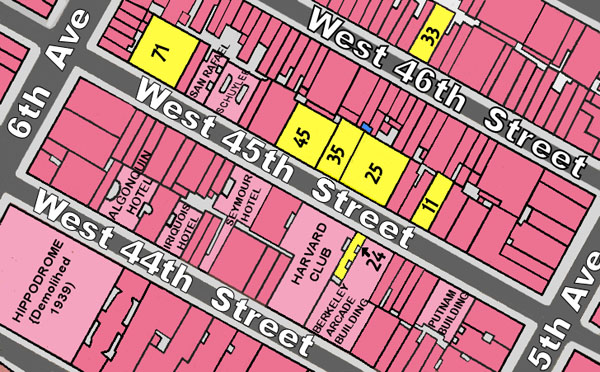
This strip of West 45th Street between 5th and 6th Avenues housed numerous studios involved in animation.
25 West 45th Street: Built 1913. 16 floors. Known as the Century Building. PATHE had offices there for a long time.
Tenants included: WINKLER PICTURES (1927-1929) * FAMOUS STUDIOS (1942-1956) * BASCH RADIO & TELEVISION PRODUCTIONS (1965-1972) * TELEVISION SCREEN PRODUCTIONS (1965-1972) * OPTICAL HOUSE (1968-1996) * CHARTMAKERS, INC. (1971) * HOWARD BECKERMAN ANIMATION (1987) * TRILOGY DESIGN at JSL, INC. (1988-1989) * JSL VIDEO SERVICES (1990-1991) * SUNFLOWER FILMS (1990-1991) * TRANS AMERICA VIDEO SERVICE (1993)
35 West 45th Street: Built 1921 with fireproof vaults by PATHE. 12 floors. It was known as the Pathé Exchange Building. It became the property of RKO in 1930 when RKO absorbed Pathé. Transfilm bought the building in 1946, rechristening it as the Transfilm Building. It became the property of Ohio’s Buckeye Corporation when they bought Transfilm in 1959.
Tenants include: TED ESHBAUGH STUDIO (1937-1950) * TECHNIFILM LABORATORIES, INC. (1938-1939) * TRANSFILM (1941-1960) * FAMOUS STUDIOS (1942-1966) * EMERSON YORKE STUDIOS (1943-1949) * LOUIS de ROCHEMONT ASSOCIATES (1949-1953) * ARCHER PRODUCTIONS (1949-1951) * ROBERT H. KLAEGER ASSOCIATES, INC. (1961-1964) * KAMENY FILM PRODUCTIONS (1962-1964) * CINE-METRIC (1966-1972) * CREATIVE OPTICAL (c.1969) * ACI PRODUCTIONS (1970-1976) * TRI-PIX FILM SERVICE (1979) * COMPUTER OPTICALS (1979) * IRV LEVINE ASSOCIATES (1979-1981) * ROWOHLT ANIMATION (1981) * RB/MAVERICKS (1985-1991)
45 West 45th Street: Known as the Hearn Building. Built 1923. 16 Floors. The ART FILM CO. was at that site in 1920 before this building went up.
Tenants included: WILLARD PICTURES, INC. (1945-1979) * EAST COAST PRODUCTIONS (1956-1963) * ANSEL FILM STUDIOS (1957-1958) * LARS CALONIUS PRODUCTIONS, INC. (1957-1966) * ANIME, INC. (1958-1959) * DISCOVERY PRODUCTIONS (1959) * JAMES SEAMAN (1959) * VIKING FILMS (1959-1966) * SCUDDER BOYD FILMS (1959-1960) * ANI-LIVE EDITING SERVICE (1960-1987) * WILLIAM NEMETH STUDIO (1963) * PABLO FERRO FILMS (1964-1977) * STANART STUDIOS (1964-1972) * PEN & BRUSH STUDIO (1966-1971) * SAVAGE-FRIEDMAN PRODUCTIONS (1965-1967) * COASTAL FILM SERVICE (1966-1975) * CHANNEL FILMS (1967-1990) * LEO & DICKSON OPTICS, INC. (1969) * SEL ANIMATION SERVICE (1969) * CINETRIX EFFECTS, LTD. * RAINBOW FILM EFFECTS (1969-1987) * KAP V FILMS (1970-1971) * HAL SEEGER PRODUCTIONS (1970-1994) * FILMART COMMUNICATIONS (1971) * SUNDRIWORKS (1975) * DAISIE ANIMATION (1975) * PHOS-CINE (1977) * 8th FRAME CAMERA (1979-1980) * LARRY QUE (1979-1981) * SCHIRANO CAMERA (1979) * OMNI-GRAPHICS (1981) * HOWARD BECKERMAN ANIMATION (1988-1989) * GIFFORD-KIM PRODUCTIONS (1988-1989)
71, 24, and 11 West 45th Street all had a couple of studios there. Elektra Films was at 33 West 46th Street. Richard Williams Raggedy Ann and Andy was produced out of the Berkeley Building at 19 West 44th Street (during 1975-1977). If we expanded this map out a few blocks in any direction there were studios scattered all over. I will try to put them in perspective as best as I am able.
Mistakes! Yes, I make them. I made one last article by placing John and Margaret Bray’s farm in Highland Falls, NY. It was actually in the town of Highland, some twenty-five miles up the Hudson River. I copied that mistake directly from Donald Crafton’s book Before Mickey: The Animated Film 1898-1928. Understand that I’m not knocking Crafton’s work. He did a fine job expanding our understanding of Bray Studios. We all make mistakes. I’m counting on the rest of you to correct me when I do.
For anyone interested in the early cartoons I recommend American Animated Films: The Silent Era 1897-1929 by Denis Gifford. I found a hardcover online for about nine bucks. And those guys, Maltin and Crafton, were kicking it old school – no computer databases. They’ve got the 1950 Census records out now, so we can learn more about guys like Mako Oike and Robert Tinfo. Then down the line we’ll start a game called Six Degrees of Fred Mogubgub.
I’m hoping the New York library posts 1950 phone books as it did for 1940. These links might be helpful to some of you.
1940 BRONX
https://digitalcollections.nypl.org/items/f38b4f90-97cc-0135-4973-6bf0654b7a93
1940 BROOKLYN
https://digitalcollections.nypl.org/items/49b631a0-97d9-0135-afb3-0c97ae709799
1940 QUEENS
https://digitalcollections.nypl.org/items/951f4d80-9a59-0135-78ce-596d2a137298
1940 STATEN ISLAND
https://digitalcollections.nypl.org/items/d4608e80-9ae9-0135-f057-3b2a31113b3a
1940 MANHATTAN
https://digitalcollections.nypl.org/items/76112f90-97e4-0135-b4a4-5b8e9092cb84
Los Angeles Phone Books
https://rescarta.lapl.org/ResCarta-Web/jsp/RcWebBrowseCollections.jsp


 BOB COAR made his way in this world as a muralist and sign painter, illustrating on just about every surface imaginable. A life-long fan of animation, he is currently searching for digital, or actual, copies of Top Cel.
BOB COAR made his way in this world as a muralist and sign painter, illustrating on just about every surface imaginable. A life-long fan of animation, he is currently searching for digital, or actual, copies of Top Cel. 




























































I’ve known New Yorkers who swore up and down to me that Brooklyn and Queens are not part of Long Island. Showing them a map made absolutely no difference; they still insisted that Long Island ends at the Nassau County line. So I’m not surprised to find a degree of ambiguity on that point here, for example your referring to “Long Island”, rather than Queens, as one of the five boroughs of New York. While Queens and Brooklyn are geographically part of Long Island, not all of L.I. is part of NYC.
Which brings me to Winsor McCay’s home. According to an old post on this website’s predecessor Cartoon Brew, McCay lived at 1811 Voorhies Avenue in the Sheepshead Bay neighbourhood of the Borough of Brooklyn (which, yes, is situated on Long Island no matter what anybody says). Back in the day the street was known as “Millionaire’s Row”. Is that where McCay drew the pictures for the Little Nemo film, or was he living in another house (on the same island) in 1911?
It’s semantics. While Queens and Brooklyn are physically part of Long Island, we Queens folk nowadays like to differentiate based on those counties that are part of NYC, versus those that are part of NYS. We find it easier to colloquially refer to ‘Long Island’ as the non-NYC counties of Nassau and Suffolk. And culturally, we hope to feel and be seen as somewhat different in that sense, too!
Well into the mid-20th century, it was still commonplace to hear Queens residents referring to their hometowns as being part of Long Island. This was a cultural holdover from the days before Queens County was consolidated as part of New York City in 1898. In recent years, elderly celebrities like Tony Bennett could still be heard referring to their hometowns as “Astoria, Long Island” for instance. Though, I suspect *that* more recent phenomenon is more a side effect of elderly folks like Bennett who have not actually lived in Queens for the past few decades; the sentiment or phrasing is a ghost of their earlier lives here. Most living people here really no longer mention Long Island alongside local neighborhoods.
—a lifelong Queens resident
As a Long Islander since infancy who was born in the Bronx, I find this information fascinating. I can’t wait to look in the Bronx phone book.
Yes, it can be very confusing to people not from the area to get the terms right. When we speak of “Long Island,” we generally are speaking of just Nassau and Suffolk. But when we speak of “the city,” it usually refers to just Manhattan! If you want to refer to the whole city, you say “the five boroughs,” and if you want to refer to the part of the city outside of Manhattan, you say “the outer boroughs.” And never say that people live “in” Long Island, it’s always “on”!
I see. These semantic conventions give rise to some logical absurdities, such as the idea that Long Island City isn’t really “on” Long Island. But in a city with as long and complex a history as New York, such things are bound to happen.
I think any intelligent local would agree that Long Island City is on Long Island, geographically speaking—we’d just refer to its more immediate cultural alliance or allegiance, which is with Queens, and then New York City (i.e. not Nassau or Suffolk counties, at all). These colloquialisms help us quickly define what’s what, in terms of culture and legality.
A friend who grew up in Queens maintained that Long Island City was named after Long Island but isn’t part of it, just as Virginia City, Nevada, isn’t in Virginia. I didn’t buy her logic, but she didn’t explain it as well as you. She also said the correct pronunciation is “Long Guyland”.
Wow, that Media History website is pretty useful. Like many of us I often look at the magazines available at archive.org but their search engine isn’t always easy to handle and it seems that the Lantern one can help quite a bit. So thank you ! And I guess you answered at large to much of the questions that arrose about your sources 😉
Paul, I make it a habit to never argue with a New Yorker about their geography. Your clarification is apprciated. I learn much from you.
But arguing with New Yorkers, about anything at all, is just so much fun!
Famous Studios was in a better neighborhood than I thought. (I figured they simply moved back to the former Fleischer site, or in the old Paramount Building.) Not that it made the cartoons any better.
Say, Bob, where was/were the building(s) that Ralph Bakshi’s studio occupied during his days producing animated feature films in the 70’s & early 80’s?
Wow! Fantastic article! I didn’t realize how many studios have been in Manhattan but I shouldn’t be too surprised.
Did I miss something? Why didn’t King Features Syndicate make the list? I don’t think they produced any animation there but they were producers nevertheless.
And “Manhattan is bordered by the Atlantic Ocean to the east,” don’t you mean the East River?
And what about Gamma Productions? I never visited their studios but did visit the recording studios they used (in Mid-town?) back in the 60’s!
The only Gamma I know of is Mexico.
BAKSHI, RALPH
Started out at Terrytoons and went on to run the place.
Headed Paramount Cartoon Studios in its last days.
Went to work for Steve Krantz after that on SPIDERMAN cartoons.
1969-1970: Ran RALPH’S SPOTS to do commercials with pop artist Peter Max from Krantz’s studio at:
250 West 57th Street.
Bakshi then began work on FRITZ THE CAT in a space located along 32nd Street near Seventh Avenue. Midway through production he moved to Hollywood to finish the film.
1983: Bakshi later moved his studio to South Salem, NY with the intention of retiring to the life of a painter. In 1986 he began commuting to Hollywood where he worked on projects with young animators,
2004: Bakshi opened an animation school in Silver City, New Mexico.
As to Gamma, yes I think that’s right! I should have written Total Television! Weren’t they in Mid-town?
TOTAL TELEVISION PRODUCTIONS, INC.
F. 1959
366 Madison Avenue (1967)
Treadwell D. Covington
Made commercials and TV shows for General Mills Cereals, including UNDERDOG and TENNESSEE TUXESO. Animation was done in Mexico City at Gamma Studios.
(see LEONARDO TELEVISION PRODUCTIONS)
Hi! I just noticed my dads name in your article, Robert Tinfo! Wow! Amazing you dug that up. Need more info, contact me😊